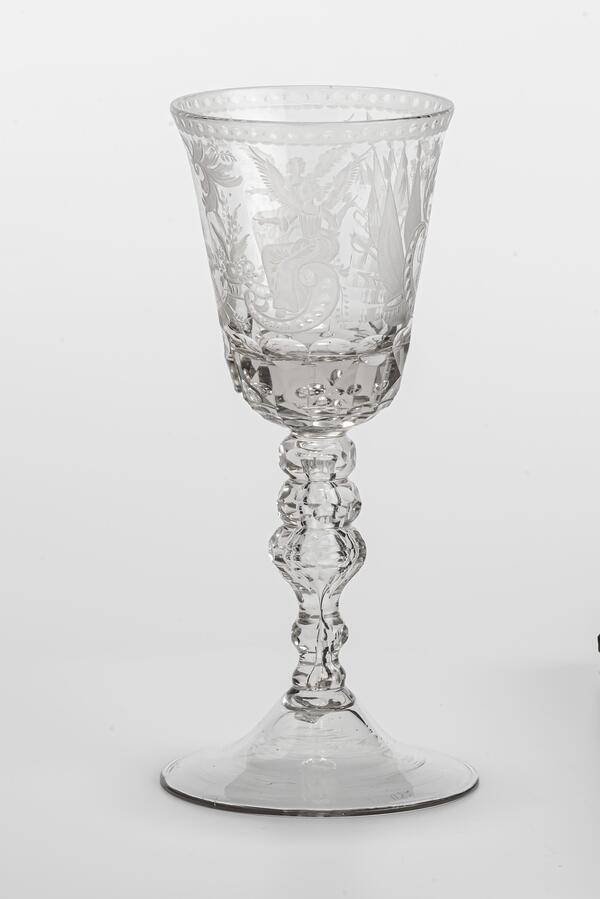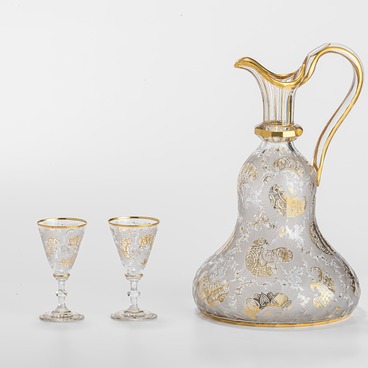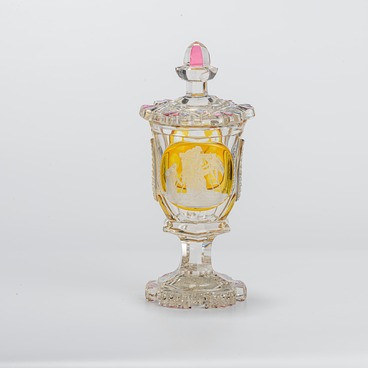The so-called “representative” crystal goblets “about the sovereign’s everyday life” were known in Russia as far back as the reign of Tsar Alexey Mikhailovich, and in the early 18th century, they became popular among the nobles. At the time of Peter I, such a goblet, or a “big glass”, was always present on the table during banquets. As a rule, it was decorated with the image of Saint George, a double-headed eagle and the emperor’s portrait or monogram. On the reverse side, there was a large-scale greeting or an image of military trophies.
During the reign of Anna Ioannovna, goblets became simpler in terms of design. However, the time of Yelizaveta Petrovna was the heyday of “representative” goblets.
One of them is on display at the exhibition.
Representative engraved glass was the mirror of the era, it both recorded military victories and praised the empress. The imposing design of the goblets commemorated victories and important state events. Goblets with the profile and monogram of Elizabeth I were manufactured to mark the empress’s name days and the anniversaries of her accession to the throne.
The products of this period were characterized by a combination of baroque form and light rocaille decor. The former restrained style gave way to elaborate compositions: the surface of the goblet was completely covered with patterns.
New stylistic trends did not rule out the depiction of a plot that was adopted during the reign of Peter I. The stem consisting of faceted “knobs” symbolizes a pedestal. The glass bubbles with a purple shade create the sparkling effect: in the thick bottom, there is one larger air bubble, and there are five smaller ones around. On one side of the goblet, there is an engraved profile bust of Yelizaveta Petrovna. It is surrounded by rocaille patterns with images of the All-Seeing Eye (top) and two female figures — allegories of Glory (right and left). On the reverse side, the monograms of Elizabeth are encased in rocaille. They are flanked by military attributes, at the top there is a heraldic eagle and a crown.
Two Elizabethan goblets from the middle of the 18th century are on display in the Museum of Glass and Crystal.
However, there is an entry about these goblets in the historical record “150 years of the Nikolsko-Bakhmetevsky crystal factory of Prince A.D. Obolensky”. The information was shared in 1914 by Nikanor Ivanovich Protasov, a leading specialist in studying the glassmaking of the last third of the 18th — first third of the 20th centuries. According to him, these goblets may be the latest samples made at the Nikolsko-Bakhmetevsky factory that copied the Saint Petersburg models.
During the reign of Anna Ioannovna, goblets became simpler in terms of design. However, the time of Yelizaveta Petrovna was the heyday of “representative” goblets.
One of them is on display at the exhibition.
Representative engraved glass was the mirror of the era, it both recorded military victories and praised the empress. The imposing design of the goblets commemorated victories and important state events. Goblets with the profile and monogram of Elizabeth I were manufactured to mark the empress’s name days and the anniversaries of her accession to the throne.
The products of this period were characterized by a combination of baroque form and light rocaille decor. The former restrained style gave way to elaborate compositions: the surface of the goblet was completely covered with patterns.
New stylistic trends did not rule out the depiction of a plot that was adopted during the reign of Peter I. The stem consisting of faceted “knobs” symbolizes a pedestal. The glass bubbles with a purple shade create the sparkling effect: in the thick bottom, there is one larger air bubble, and there are five smaller ones around. On one side of the goblet, there is an engraved profile bust of Yelizaveta Petrovna. It is surrounded by rocaille patterns with images of the All-Seeing Eye (top) and two female figures — allegories of Glory (right and left). On the reverse side, the monograms of Elizabeth are encased in rocaille. They are flanked by military attributes, at the top there is a heraldic eagle and a crown.
Two Elizabethan goblets from the middle of the 18th century are on display in the Museum of Glass and Crystal.
However, there is an entry about these goblets in the historical record “150 years of the Nikolsko-Bakhmetevsky crystal factory of Prince A.D. Obolensky”. The information was shared in 1914 by Nikanor Ivanovich Protasov, a leading specialist in studying the glassmaking of the last third of the 18th — first third of the 20th centuries. According to him, these goblets may be the latest samples made at the Nikolsko-Bakhmetevsky factory that copied the Saint Petersburg models.





